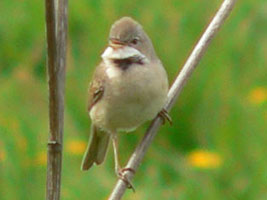Garden Warbler
(Sylvia borin)
In its plumage there are absolutely no contrasting colors: the top is single-colored greenish-grey, the bottom is light greenish.
The garden warbler lives very reticently among dense bushes, and usually it can be only glimpsed for a short moment in foliage.
Its melodious song is similar to sonorous and gentle murmur of a streamlet.
The nest is built by both partners, near the ground, in interwoven branches and last year’s grass, frequently in thickets of raspberry or blackberry, sometimes in heaps of brushwood, always in shadow. It is excellently hidden. The nest of the garden warbler is a "bowl" made of last year’s blades.
It feeds mainly on beetles and caterpillars.
Whitethroat (Common Whitethroat)
(Sylvia communis)
The top of its plumage is light grey-brown; the bottom is white; on the wings, there are red strips. The top of the male’s head is grey; the female’s is brown.
In spring, upon returning from the African tropics, singing males jump from a branch to a branch, inflate the neck and lift feathers on the head. Or sometimes, they fly up, but at once come back, as if were confused by something.
Their song is quiet, hasty, rather short chirping. Males sing all spring all day long and cease singing only in the middle of July.
The nest is built by both spouses — always near the ground in bushes, thickets of nettle or wormwood. Like all warblers, they construct their nest as a woven "bowl". On the top edge of the nest, there is a border made of white lumps of vegetative fluff. Walls are not dense; they are made mainly of last year’s blades. A lining inside the nest often contains mammals’ hair.
The young hatch naked, and in first days they need to be warmed long. Both parents feed them.
Whitethroats feed mainly on insects. They destroy a lot of pests of forest and agriculture. They love also juicy fruits and berries.
Willow Warbler
(Phylloscopus trochilus)
The willow warbler has reddish-grey or greenish-grey top of body; the belly and eyebrow are yellow-white.
It occurs everywhere where there are young deciduous forests, alder-birch groves or even willow thickets with rich motley grass.
The song of males is a set of high whistles merging in one trill which gradually quiets down. Quite often, singing males can be seen on tops of trees or bushes.
They sing all summer. And even in September, it is still possible to hear their lovely whistles.
The nest of the willow warbler — a hardly noticeable shelter — is arranged on the ground among moss and grass, frequently under the cover of a bush or tree. Inside it is richly lined with elk hair, feathers of blackcocks, pigeons — and looks very cozy.
During construction of the nest, the male is silent, but with the beginning of brooding, he starts to sing again.
Sedge Warbler
(Acrocephalus schoenobaenus)
This birdie is slightly less in size than the sparrow. It has strips on the head and back, which resemble the strips of the badger. Also a bright light eyebrow is especially visible. The belly is white.
The sedge warbler nests in reeds and bushes on coasts of water reservoirs or on damp meadows.
The song of this birdie is peculiar due to its special rhythm. Pure whistles and crackling sounds alternate in it. When listening to it, you are amazed by tirelessness of the singer. It begins the song sitting on a stem, but, having grown excited, quite often darts off and, without stopping singing soars up in air. Having flown a little, it sits down again. It does so whole days and nights. Calls of sedge warblers infuse perfectly in the natural sounds of reed thickets — in scratches of stalks shuddered by wind, in the sounds originating from waves of water and rustling of foliage. And if we succeed in noticing this, we will like the songs of sedge warblers and remember them forever.
.jpg)

.jpg)
-2.jpg)